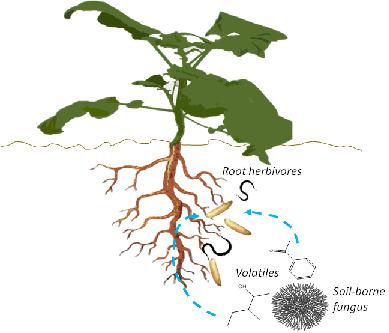当前位置:
X-MOL 学术
›
Ecol. Entomol.
›
论文详情
Our official English website, www.x-mol.net, welcomes your
feedback! (Note: you will need to create a separate account there.)
Volatiles from the fungus Fusarium oxysporum affect interactions of Brassica rapa plants with root herbivores
Ecological Entomology ( IF 2.0 ) Pub Date : 2020-10-03 , DOI: 10.1111/een.12956 Kay Moisan 1, 2 , Marcel Dicke 1 , Jos M. Raaijmakers 2, 3 , Elvira Rachmawati 1 , Viviane Cordovez 2, 3
Ecological Entomology ( IF 2.0 ) Pub Date : 2020-10-03 , DOI: 10.1111/een.12956 Kay Moisan 1, 2 , Marcel Dicke 1 , Jos M. Raaijmakers 2, 3 , Elvira Rachmawati 1 , Viviane Cordovez 2, 3
Affiliation

|
1. Soil is a diverse and heterogeneous environment where chemicals mediate numerous interactions between soil organisms and plants. To date, studies have extensively addressed volatile-mediated interactions between soil microorganisms and the effects of microbial volatiles on plant growth. Yet, to our knowledge, it remains to be explored whether volatiles from soil-borne fungi can influence plant interactions with root herbivores, facilitating or hampering performance of competitors that share the same host plant. 2. In the present study, we investigated the effects of volatiles emitted by the soil-borne fungus Fusarium oxysporum on the performance of two root herbivores: the plant parasitic cyst nematode, Heterodera schachtii, and the insect root herbivore, Delia radicum, upon infestation of Brassica rapa roots. 3. Fungal volatiles slowed down the development of the root nematode cysts but increased their size, suggesting an enhanced egg load. In contrast, the performance of the insect root herbivore was unaffected by the exposure of roots to fungal volatiles. Additionally, fungal volatiles promoted the growth of plants infested with the root nematode, but not of those infested with the insect root herbivore. 4. Together, our data show that volatiles from a soil-borne fungus can affect root interactions with root herbivores. Increased production of nematode eggs and plant growth promotion suggest a specific modulation of root-herbivore interactions by fungal volatiles.
中文翻译:

真菌尖孢镰刀菌的挥发物影响芸苔属植物与根食草动物的相互作用
1. 土壤是一个多样化和异质的环境,其中化学物质介导了土壤生物和植物之间的众多相互作用。迄今为止,研究已经广泛解决了土壤微生物之间挥发物介导的相互作用以及微生物挥发物对植物生长的影响。然而,据我们所知,土传真菌的挥发物是否会影响植物与根系食草动物的相互作用,促进或阻碍共享同一寄主植物的竞争者的表现,仍有待探索。2. 在本研究中,我们研究了土传真菌尖孢镰刀菌 (Fusarium oxysporum) 排放的挥发物对两种根食草动物性能的影响:植物寄生胞囊线虫 Heterodera schachtii 和昆虫根食草动物 Delia radicum 对侵染的影响油菜根。3. 真菌挥发物减慢了根线虫包囊的发育,但增加了它们的大小,表明卵子负荷增加。相比之下,昆虫根草食动物的表现不受根部暴露于真菌挥发物的影响。此外,真菌挥发物促进了被根线虫感染的植物的生长,但不会促进被昆虫根系食草动物感染的植物的生长。4. 总之,我们的数据表明来自土传真菌的挥发物会影响根与根食草动物的相互作用。线虫卵产量的增加和植物生长促进表明真菌挥发物对根 - 食草动物相互作用的特定调节。昆虫根系食草动物的表现不受根部暴露于真菌挥发物的影响。此外,真菌挥发物促进了被根线虫感染的植物的生长,但不会促进被昆虫根系食草动物感染的植物的生长。4. 总之,我们的数据表明来自土传真菌的挥发物会影响根与根食草动物的相互作用。线虫卵产量的增加和植物生长促进表明真菌挥发物对根 - 食草动物相互作用的特定调节。昆虫根系食草动物的表现不受根部暴露于真菌挥发物的影响。此外,真菌挥发物促进了被根线虫感染的植物的生长,但不会促进被昆虫根系食草动物感染的植物的生长。4. 总之,我们的数据表明来自土传真菌的挥发物会影响根与根食草动物的相互作用。线虫卵产量的增加和植物生长促进表明真菌挥发物对根 - 食草动物相互作用的特定调节。
更新日期:2020-10-03
中文翻译:

真菌尖孢镰刀菌的挥发物影响芸苔属植物与根食草动物的相互作用
1. 土壤是一个多样化和异质的环境,其中化学物质介导了土壤生物和植物之间的众多相互作用。迄今为止,研究已经广泛解决了土壤微生物之间挥发物介导的相互作用以及微生物挥发物对植物生长的影响。然而,据我们所知,土传真菌的挥发物是否会影响植物与根系食草动物的相互作用,促进或阻碍共享同一寄主植物的竞争者的表现,仍有待探索。2. 在本研究中,我们研究了土传真菌尖孢镰刀菌 (Fusarium oxysporum) 排放的挥发物对两种根食草动物性能的影响:植物寄生胞囊线虫 Heterodera schachtii 和昆虫根食草动物 Delia radicum 对侵染的影响油菜根。3. 真菌挥发物减慢了根线虫包囊的发育,但增加了它们的大小,表明卵子负荷增加。相比之下,昆虫根草食动物的表现不受根部暴露于真菌挥发物的影响。此外,真菌挥发物促进了被根线虫感染的植物的生长,但不会促进被昆虫根系食草动物感染的植物的生长。4. 总之,我们的数据表明来自土传真菌的挥发物会影响根与根食草动物的相互作用。线虫卵产量的增加和植物生长促进表明真菌挥发物对根 - 食草动物相互作用的特定调节。昆虫根系食草动物的表现不受根部暴露于真菌挥发物的影响。此外,真菌挥发物促进了被根线虫感染的植物的生长,但不会促进被昆虫根系食草动物感染的植物的生长。4. 总之,我们的数据表明来自土传真菌的挥发物会影响根与根食草动物的相互作用。线虫卵产量的增加和植物生长促进表明真菌挥发物对根 - 食草动物相互作用的特定调节。昆虫根系食草动物的表现不受根部暴露于真菌挥发物的影响。此外,真菌挥发物促进了被根线虫感染的植物的生长,但不会促进被昆虫根系食草动物感染的植物的生长。4. 总之,我们的数据表明来自土传真菌的挥发物会影响根与根食草动物的相互作用。线虫卵产量的增加和植物生长促进表明真菌挥发物对根 - 食草动物相互作用的特定调节。









































 京公网安备 11010802027423号
京公网安备 11010802027423号